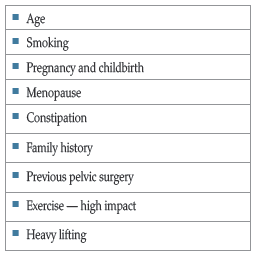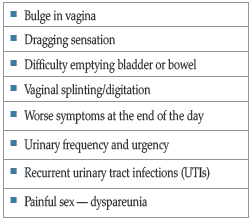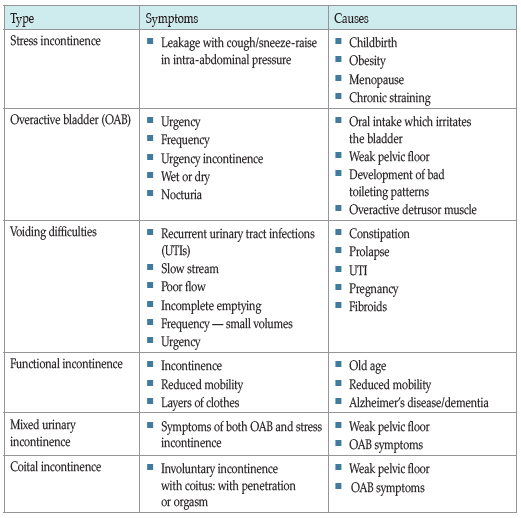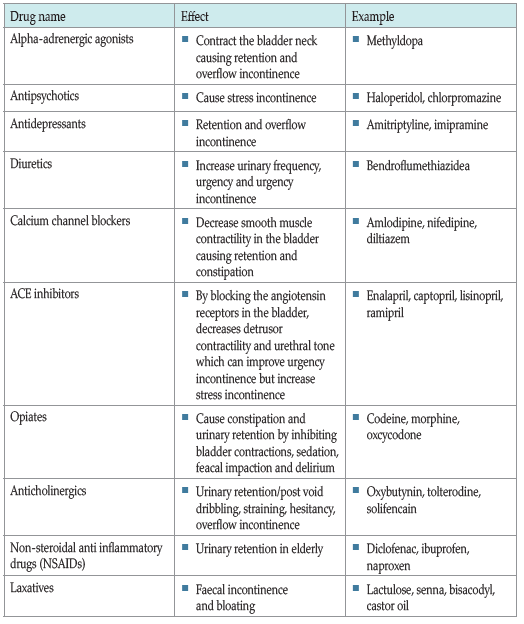References
Al-Mali M (2018) Communication skills 3: non-verbal communication. Nurs Times 114(2): 41–2
Bardsley A (2016) An overview of urinary incontinence. Br J Nurs 25(18): S14–S21
Bedoya-Ronga A, Currie I (2014) Improving the management of urinary incontinence. Practitioner 258(1769): 21–4
Blomquist JL, Munoz A, Carroll M, Handa VL, et al (2018) Association of delivery mode with pelvic floor disorders after childbirth. JAMA 320(23): 2438–47
Buckley BS, Lapitan MCM (2010) Prevalence of urinary incontinence in men, women, and children – current evidence: Findings of the Fourth International Consultation on Incontinence. Urology 76(2): 265–70
Boyd C, Stevens D (2020) Urinary incontinence: management in general practice. GM, 20 January 2020. Available online: www.gmjournal.co.uk/urinary-incontinence-in-women-management-in-general-practice
Car J, Choon-Huat Koh G, Sym Foong P, Wang CJ (2020) Video consultations in primary and specialist care during the Covid-19 pandemic and beyond. BMJ 20 Oct: 371:m3945
Colley W (2020) Colley Model. Supporting the assessment of bladder symptoms in adults. Available online: www.continenceassessment.co.uk
Digesu G, Khullar V, Cardozo L, et al (2005) P-QOL: a validated questionnaire to assess the symptoms and quality of life of women with urogenital prolapse. Int Urogynecol J Pelvic Floor Dysfunct 16(3): 176–81; discussion 181
Fedele R (2021) ‘Our eyes became a big way of communicating’: The power of communicating during COVID-19. ANMJ 6 May. Available online: https://anmj.org.au/the-power-of-body-language-in-nursing/
Haylen B, De Ridder D, Freeman R, Swift S, et al (2010) An International Urogynaecological Association (IUGA)/International Continence Society (ICS) joint report on the terminology for female pelvic floor dysfunction. Int Urogynaecol J 21: 5–26
Haylen BT, Maher CF, Barber MD, Camargo SFM, Dandolu V, Digesu A, et al (2016) International Urogynecological Association (IUGA)/International Continence Society (ICS) Joint Report on the terminology for pelvic organ prolapse (POP). Int Urogynecol J 27(2): 165–94
Herbert J (2009) Pregnancy and childbirth: the effects on pelvic floor muscles. Nurs Times 105(7): 38–41
Laws A (2020) Assessing continence issues during the Covid-19 pandemic. J Community Nurs 34(4): 16–17
Memon H, Landa V (2013) Vaginal childbirth and pelvic floor disorders. Womens Health (Lond) 9(3): 265–77
Miedel A (2009) Non-obstetric risk factors for symptomatic pelvic organ prolapse obstetrics and gynecology. Obstet Gynecol 113(5): 1089–97
Milsom I, Gyhagen M (2019) The prevalence of urinary incontinence. Climacteric 22(3): 217–22
National Institute for Health and Care Excellence (2018) Urinary tract infection (lower): antimicrobial prescribing. NICE, London. Available online: www.nice.org.uk/guidance/ng109
National Institute for Health and Care Excellence (2019) Urinary incontinence and pelvic organ prolapse in women: management. NICE Guideline (NG123) NICE, London
Nazarko L (2015) Person centred care of women with urinary incontinence. Nurse Prescribing 13(6): 288–93
Okamura K, Nojiri Y, Osuga Y (2009) Reliability and validity of the King’s Health Questionnaire for lower urinary tract symptoms in both genders. BJUI 103(12): 1673–78
Pelvic Floor Society (2021) Seizing the opportunity to improve patient care: Pelvic Floor services in 2021 and beyond. Available online: www.pelvicfloorreport.com/wp-content/uploads/2021/04/Pelvic-Floor-Report-V13-WEB.pdf
Rantell A (2017) Assessment and diagnosis of overactive bladder in women. Nurs Standard 27(52): 35–40
Rantell A (2019) Urinary incontinence and pelvic organ prolapse in primary care. Practice Nurs 30(7): 332–37
Richardson K, Hagen S (2009) The role of nurses in the management of women with pelvic organ prolapse. Br J Nurs 18(5): 294-6, 298–300
Royal College of Nursing (online) (2016) Causes of incontinence|Continence|RCN. Available online: www.rcni.com/hosted-content/rcn/continence/causes-of-incontinence
Robinson D, Anders K, Cardozo L, Bidmead J (2007) Outcome measures in urogynaecology: the clinicians’ perspective. Int Urogynecol J Pelvic Floor Dysfunct 18(3): 273–9
Royal College of Nursing (2020) Genital Examination in Women. A resource for skills development and assessment. Available online: www.rcn.org.uk/professional-development/publications/rcn-genital-examination-in-women-pub007961
Royal College of Obstetricians and Gynaecologists (2013) Pelvic organ prolapse. RCOG, London. Available online: www.rcog.org.uk/en/patients/patient-leaflets/pelvic-organ-prolapse/
Stewart E (2019) Urogynaecology. In: Holloway D (2019) Nursing management of Womens Health: a guide for nurse specialists and practitioners. Springer
Vergldt T (2015) Risk factors for pelvic organ prolapse and its recurrence: a systematic review. Int Urogynecolo J 26: 1559–73
Vermeulen CKM, Veen J, Adang C, et al (2021) Pelvic organ prolapse after laparoscopic hysterectomy compared with vaginal hysterectomy: the POP-UP study. Int Urogynecol J 32: 841–50
Wood L, Anger J (2014) Urinary incontinence in women. BMJ Sep 15; 349: g4531
Yates A (2018) How to perform a comprehensive baseline continence assessment. Nurs Times 114(5): 26–9
Yates A (2021) Continence assessment and investigations. J Community Nurs 35(2): 30–7
This article first appeared in the Journal of General Practice Nursing. To cite this article: Stewart E (2021) Pelvic organ prolapse and female urinary incontinence: assessment. J General Practice Nurs 7(4): 54–9






